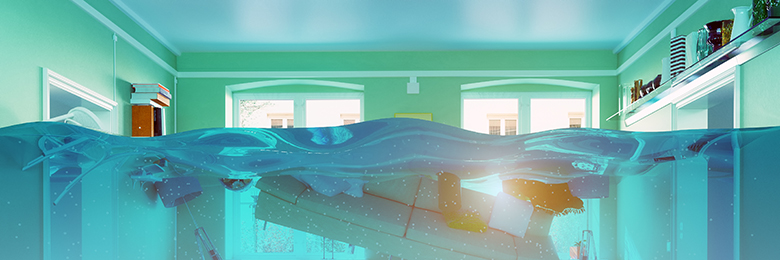Water Damage: Protecting Valuables and Property from the Most Frequent Disruptor

While folks residing on the coasts are keenly aware of the threats that hurricanes can pose in terms of water damage, most families are unaware that the main risk of water damage actually stems from within the home itself. We sat down with FOX member, Anne Martin, Senior Risk Management Specialist and Water Damage Mitigation Technical Specialist for AIG Private Client Group to get an understanding of why ultra high net worth homeowners, in particular, are so vulnerable when it comes to water damage and steps to take to prevent and mitigate the risks.
FOX: Why is water damage such a problem, especially for ultra-high net worth families with large homes?
Anne: Water damages have become an increasingly large risk to homes for the last decade, particularly water losses from the home’s internal plumbing systems. Because the risk of water damages to the home is not as overtly dramatic as the threat of hurricanes or wildfires, it is often overlooked, but it’s actually a much bigger risk to all high net worth homes.
The frequency and severity of these water losses are increasing dramatically, and recent analysis has shown that the more water points in a home, the higher the frequency of water losses. These are our clients’ high net worth homes, which typically have five or more bathrooms, and are likely to have multiple dishwashers, icemakers, wet bars, Jacuzzis and steam showers, and other additional water points particular to custom homes. All of these additional water points are opportunities for failures- connection points, supply hoses, valve assemblies and the fixtures and appliance themselves are all exposures to failure and resulting water losses. In addition to the increased frequency, high net worth homes have a much higher severity of loss. These homes have very customized wall, ceiling and floor finishes, custom trim and woodwork, imported materials, expensive electronics with extensive wiring, and customized amenities like wine cellars, golf simulator rooms, and home theaters. Even a little bit of water in the wrong place causes a catastrophic loss. The claim duration is even longer for our ultra high net worth policyholders and may result in the need for the homeowner to relocate during the repair process, further adding to the cost of the claim for the carrier and certainly increasing the inconvenience to the client. Claim repair duration for our high net worth segment is over 3 months, and for our ultra high net worth segment is over 4 months.
Water losses are the most frequent losses to high net worth homes and much more frequent than any other type of loss. Severity of the damages are higher and duration of claim and repairs are increasing, particularly with mold concerns adding more time to the remediation. All of these things combined mean it is an issue that those responsible for maintaining high net worth homes should be made aware of. Our ultra high net worth insureds have an average of 9.6 homes, but often also have the advantage of having full time property managers who can reduce the risk to the homes by pro-actively working to protect the homes by overseeing regular maintenance, review, and proactive risk mitigation.
FOX: Can you comment on why even one water damage claim can be devastating to a homeowner’s coverage?
Anne: Industry review and claims analysis have shown that a location that has had a water loss is at least twice as susceptible to having another water loss. Recent high net worth carrier claims analysis shows that the risk after having had a water loss within the last five years can be up to 3.5 times as frequent, depending on the type of loss, and that is even when the cause of the first loss has been repaired. Because all carriers have been seeing this trend of locations with water losses having a much higher frequency of additional water losses, carriers are non-renewing for water losses more than any other type of prior loss type. A high net worth homeowner may believe that a water loss was unavoidable and that after the loss it will not happen again, but quite the opposite is true. Most water damages can be prevented, and once a location has a water loss, they are far more at risk to have another loss without some kind of loss prevention mitigation.
FOX: What are the major causes of damage?
Anne: By far, the largest single segment of water losses to the high net worth homes are plumbing and appliances- that includes all the pipes in the home, water-based appliances and fixtures. These systems can fail for a number of reasons- pipes can fail due to corrosion, freezing, supply line failures, connection failures, and accidental damage. Appliances can fail due to age related failures, deterioration, drain lines failures, assembly or vessel failures. Pipes and toilets are among tops causes of plumbing and appliance losses and can be quite extensive. A quarter inch split in a pipe can release over 250 gallons of water in a day. A toilet supply line failure can release multiple times that. Even a second-floor toilet overflowing for the better part of a day can cause hundreds of thousands of dollars of damage, and major inconvenience, even when all the repair costs are being covered by the carrier.
Other causes of water damages to the home are air conditioning condensate drain line leaks, interior water damages from roof ice damming, water coming in through roofs and windows, and water infiltrating into basements.
FOX: What are some steps homeowners can take to try and prevent potential damage?
Anne: The best protection from the largest source of plumbing and appliance losses is a whole house automatic water shutoff device. These devices monitor the water in the entire plumbing system throughout the house, and if they sense a leak, they stop water flow to the house to prevent catastrophic water damages. An article in Claims Journal has indicated the automatic water shutoff devices can prevent up to 93% of plumbing and appliance losses. Other preventions against home water losses are individual appliance shutoffs that shut the water off to a single appliance, like a dishwasher, hot water heater or washing machine, if they sense a leak from that appliance. Centrally monitoring water sensors placed at high risk water loss locations can alert a homeowner to a leak- it will not stop the leak, but the homeowner has been alerted and can address the leak or send someone to do so. Other protections against water losses to the home include installing roof ice shield membrane underlayment and additional insulation for best protection against ice damming and roof leaks. For areas prone to basement flooding, having adequately sized or dual sumps pumps with back-up power supplies to be able to remove water from a sump pit or basement quickly, and most importantly, having regular maintenance and review of the major systems of the home- at a minimum, annual servicing and review of plumbing systems, HVAC systems, back-up generators and roofing are the best protections against losses. High net worth homes have regular landscaping maintenance to stay ahead of issues, and the home itself is no different. High net worth homes are like commercial buildings and need regular servicing for these sophisticated and expensive systems.
FOX: What are some important tips to beware of in the event of water damage?
Anne: Immediate action is crucial. Isolate and stop water flow- if you can shut the water to the specific area of the leak by shutting a valve to the leaking appliance or fixture, do so. If the area of the leak cannot be quickly determined, shut the water to the house- everyone should know where their water main shutoff valve is. If a basement has filled with water more than several inches, be aware that there may be a concern for wiring that is submerged, and do not walk into a sitting water situation if that is the case due to the potential for electrocution. When the water supply has been shut, if possible, it is necessary to drain, pump out or clean up whatever standing water there is. If it’s a small amount of water, the homeowner or property manager may be able to take care of this or start the process. A water damage remediation company should be brought in as soon as possible if it is more than a small localized water leak. Your claim adjuster will often help you pick a vetted remediation company, that is IICRC certified- IICRC is the remediation industry standard certification for best practices for water damage cleanup and sanitization. Remediation companies will immediately start the dry out process with professional equipment- pump outs, dryers and blowers, drying agents for contents, and quick remediation is also necessary to minimize the potential for mold growth. If the water damage is from ‘grey’ or ‘black’ water- any water source that is not clean, clear domestic supply water, such as drain failure or sewer back up, the areas must be specially treated to kill dangerous bacteria. Unless it is a very small leak, the cleanup is generally not a do it yourself job. For the best protection of the family’s health, the home, and the contents, a professional remediation company should be brought in as soon as possible to start the dry out and clean up. Water may not seem like a large hazard to the high net worth segment, but in the wrong places, it certainly can be.
Insurance carriers that specialize in insuring high value homes often have a loss prevention department with a dedicated staff for providing personalized and concierge water loss prevention assistance for their insureds’ homes and possessions. Please check with your broker to see what programs are available from your carrier to help you protect your home.
~~~
